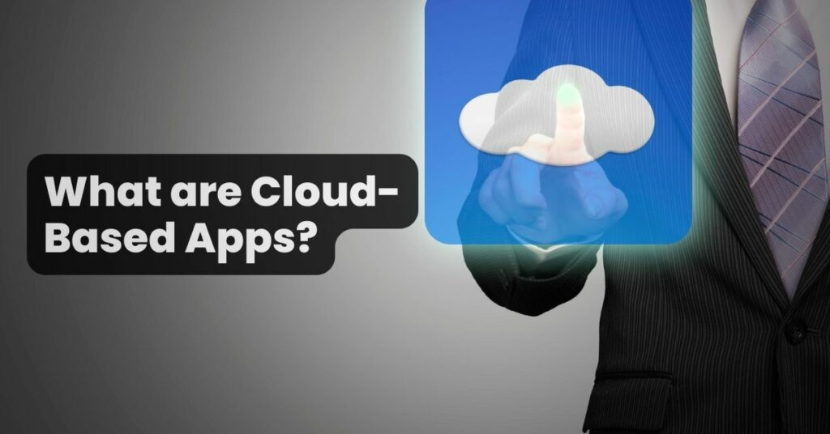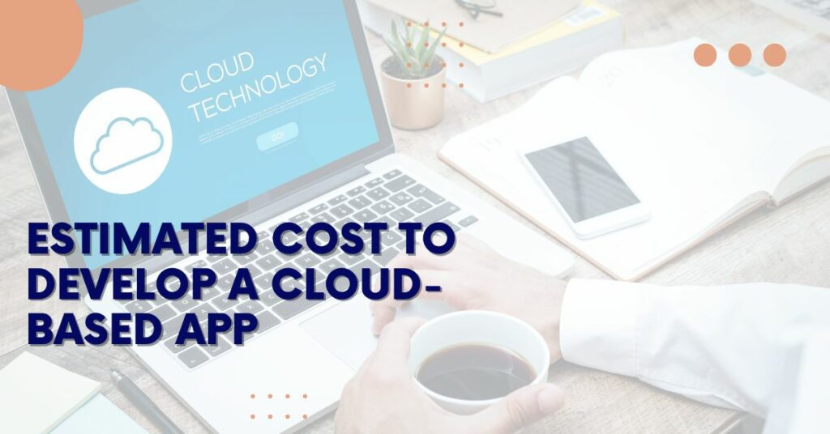Table of Contents
- Summary
- Introduction
- What are Cloud-Based Apps?
- Why are Cloud-Based Apps Gaining Popularity in Recent Times?
- Why You Should go for Cloud Apps?
- 1.Increased Flexibility and Scalability
- 2.Facilitates Improved Collaboration
- 3.Saves You a Huge Money
- 4.No More Worries about App Security
- 5.Can be Accessed Anytime, anywhere
- How to Develop a Cloud-Based App?
- Step- By-Step Guide to Developing a Successful Cloud-Based App
- Step 1. Plan Your App
- Step 2. Research the Competition
- Step 3. Develop a Prototype
- Step 4. Choose the Right Cloud platform
- Step 5. Select the Right Development Tools and Frameworks
- Step 6. Start Building MVP
- Step 7- Develop Wireframes/Mockup of App
- Step 8. Develop a robust testing plan
- Step 9. Deploy Your App
- Step 10. Launch and Promote your app
- Factors Affecting Cloud App Development Cost
- App Complexity and Feature Set
- Type of Cloud Infrastructure and Integration Needs
- UI/UX Design and Testing Requirements
- Development Team’s Region and Expertise
- Estimated Cost to Develop a Cloud-Based App
- Estimated Cost Range for Cloud App Development
- Future Trends in Cloud App Development
- AI and Automation Integration
- Serverless Computing
- Multi-Cloud Strategies
- Edge Computing
- Why Choose QSS Technosoft for Cloud App Development
- Conclusion
- FAQ Section
Summary
This blog explores why cloud-based apps have become a major trend in the digital era. It explains their growing popularity, core benefits like scalability, flexibility, and cost efficiency, and provides a step-by-step guide to cloud app development. The post highlights key factors affecting development costs, including infrastructure, design, and team expertise. It also discusses future trends such as AI integration, multi-cloud strategies, and serverless computing. Additionally, it showcases QSS Technosoft’s expertise in delivering scalable and secure cloud solutions. Finally, it encourages businesses to embrace cloud technology for enhanced performance and growth.
Introduction
The mobile app industry is growing at an unprecedented rate. In fact, according to recent statistics, the global mobile app market is expected to reach $935 billion by 2025. With such a large and rapidly growing industry, it's no wonder that more and more businesses are looking to get in on the action. But with so many options out there, it can be hard to know where to start. The answer is cloud apps!
With so much talk about the cloud these days, it's no wonder that businesses are looking to move their apps and data there too. One option that is becoming increasingly popular is cloud-based mobile apps. The reason behind this massive popularity is- Cloud-based apps can be data accessed from anywhere, at any time, and from any device. They are also more scalable and easier to manage than traditional, on-premises apps.The global market for public cloud services is forecasted to reach $679 billion by 2024.
QSS Technosoft, a trusted cloud app development company, helps enterprises leverage cutting-edge cloud solutions to boost performance and scalability.
In this blog ,we will explores cloud-based apps, their business benefits, development steps for scalable cloud solution for your business, and estimated development costs.
What are Cloud-Based Apps?

A cloud-based app is a type of mobile software that runs on the cloud, instead of on your local computer or server. This means that you can access your data and files from anywhere, as long as you have an internet connection. Cloud-based apps have many benefits, including increased collaboration, flexibility, and scalability. They can also help reduce costs, as there is no need to install or maintain local software.
Some popular cloud-based apps include Google Drive, Dropbox, Office 365, Adobe Creative Cloud, and various web apps. These apps offer users the ability to access their files and data from anywhere and can be used on a variety of mobile devices.
As per recent research, cloud-based apps will continue to grow in popularity and usage. A recent study by Forrester found that 74% of enterprises will be using cloud-based apps for mission-critical workloads by 2022. This is up from just 47% in 2018. Wondering why such massive popularity? Continue reading the blog.
Why are Cloud-Based Apps Gaining Popularity in Recent Times?

There are a number of reasons why cloud-based apps are becoming more popular. One reason is that they offer improved scalability. Cloud-based apps can be quickly scaled up or down to meet changing business needs. This is in contrast to traditional ones, which can be more difficult and costly to scale.
Another reason for the popularity of cloud-based apps is that they offer greater flexibility. Businesses can choose from a wide range of cloud-based apps to meet their specific needs. They can also easily integrate cloud-based apps with other business systems. Previously the software was more difficult to customize and integrate.
Finally, cloud-based apps can offer significant cost savings compared to traditional, on-premises software. Cloud providers typically charge based on a pay-as-you-go model, which can save businesses money compared to the upfront costs of purchasing and deploying on-premises software. In addition, cloud-based apps often include automatic updates and upgrades, which can further reduce costs.
There are plenty of other reasons to develop cloud-based mobile apps. The following are some of the most compelling:
- Saves Additional costs: With cloud-based apps, it's easy to scale up or down as needed, without having to worry about expensive infrastructure costs.
- Always up-to-date: Since cloud-based apps are updated automatically, you can be confident that your users are always using the latest version.
- Reduced development and maintenance costs: By leveraging the power of the cloud, you can save on development and maintenance costs since much of the work is done by the cloud provider.
- Improved security: Cloud providers typically have robust security systems in place, so you can be sure your data is safe and secure.
Read Also : How to Choose the Best HIPAA-Compliant Cloud Storage?
Empower Your Digital Vision with an Award-Winning Tech Partner
QSS Technosoft is globally recognized for innovation, excellence, and trusted delivery.
- Clutch Leader in App Development 2019
- Ranked Among Top 100 Global IT Companies
- Honored for Cutting-edge AI & Mobility Solutions
Why You Should go for Cloud Apps?
Cloud-based mobile apps offer a number of advantages over traditional, on-premise apps. Perhaps the most significant advantage is that they can be deployed much faster and at a lower cost. Cloud-based apps also offer greater flexibility, as they can be easily scaled up or down to meet changing needs. Additionally, cloud-based apps are typically more reliable and secure than on-premise apps, as they benefit from the expertise of the cloud provider.
Another key advantage of cloud-based apps is that they can be accessed from anywhere, at any time. This is particularly beneficial for organizations with employees who work remotely or who travel frequently. With a cloud-based app, employees can access the latest version of the app from any location with an internet connection and within secure cloud environments. Finally, cloud-based apps are often easier to maintain than on-premise apps, as updates can be rolled out quickly and automatically by the cloud provider, and new versions can be seamlessly distributed through app stores.n-premise apps, as updates can be rolled out quickly and automatically by the cloud provider.
Let's learn about all these advantages of cloud-based apps in detail below-
1.Increased Flexibility and Scalability
Cloud-based apps are more flexible and scalable than on-premises apps. With cloud-based apps, you can quickly scale up or down as needed without having to make any infrastructure changes. This is perfect for businesses that experience seasonal spikes in demand or unexpected growth spurts.Cloud application development benefits from a flexible pricing model, generally based on usage, which can lower initial costs.
2.Facilitates Improved Collaboration
Cloud-based mobile apps facilitate collaboration by allowing users to share real-time data and documents. This makes it easier for teams to work together, regardless of location. For example, you can easily share documents and files, make comments and edits in real-time, and track who's working on what with built-in activity logs.
3.Saves You a Huge Money
Developing cloud-based mobile apps can save you money in the long run as you don't have to invest in expensive on-premises hardware and software. You also don't have to hire extra IT staff to manage your system since the provider takes care of all that for you. Additionally, there are no maintenance costs associated with cloud-based app development.
4.No More Worries about App Security
Cloud-based app development platforms offer increased security features, such as data encryption and user authentication, which help to protect your data from unauthorized access. When you store data in the cloud, it's more secure than keeping it on your own premises. Cloud providers have robust security measures in place to protect your data from cyberattacks.
5.Can be Accessed Anytime, anywhere
convenient for remote workers and gives everyone the flexibility to work from wherever they want, ensuring seamless data access across all devices. convenient for remote workers and gives everyone the flexibility to work from wherever they want.
How to Develop a Cloud-Based App?

The cloud-based app development market is growing rapidly. In fact, it is expected to reach $371 billion by 2025. With so much opportunity in this space, it's no wonder why more and more businesses are looking to develop a cloud-based app. But what does it take to develop a successful cloud-based app? Let's explore the key considerations for developing a cloud-based app, from architecture to security to scalability.
Step- By-Step Guide to Developing a Successful Cloud-Based App
Step 1. Plan Your App
First, you need to plan your app idea & then define the scope and requirements of your app. Creating a clear roadmap at the outset will save you time and money down the road.During the discovery stage, business goals and user needs are analyzed to define the app's functionality.The discovery stage may take 30-40 hours and cost around $4,500.
Here are some questions to consider:
- What is the purpose of your app? What problem does it solve?
- Who is your target audience? How will they use your app?
- What features do you need to include to make your app successful?
- What kind of data will your app be handling? How will it be stored?
These are just a few of the questions you need to answer before you can start developing your cloud-based app. Once you have a good understanding of what you're building, you can move on to setting up your development environment. You should create a minimum viable product (MVP) to test the market demand.
Step 2. Research the Competition
See what similar apps are out there and what they're doing well (and not so well). This will help inform your own app development process.
Step 3. Develop a Prototype
Once you've validated that there is a market demand for your app, the next step is to develop a prototype. This will help you not only visualize your app but also give you something to show potential investors and partners. Prototyping doesn't have to be complicated or expensive – there are many online tools that can help you quickly and easily create a prototype.
Step 4. Choose the Right Cloud platform
If you want to develop a cloud-based app, the first thing you need to do is determine which type of cloud platform you want to use. Not all mobile platforms are created equal—so do your research to find the one that best suits your needs (and budget).
There are three main types of cloud platforms: public, private, and hybrid.
- Public cloud platforms like Amazon Web Services (AWS) and Microsoft Azure are owned and operated by large companies that rent out their infrastructure to anyone who wants to use it.
- Private cloud platforms like OpenStack and VMware vCloud are owned and operated by a single organization, usually a company, and can only be used by that organization.
- Hybrid cloud platforms like Google Cloud Platform (GCP) combine elements of both public and private clouds, giving organizations the flexibility to use the best option for each individual workload.
Step 5. Select the Right Development Tools and Frameworks
Once you've decided on a platform, the next step is to choose a programming language, tools & frameworks. The most popular languages for developing cloud-based applications are Java, Python, Laravel, Ruby on Rails, and Node.js. However, there are many other options available, so be sure to do your research before making a decision. Select those that will work best for your particular project requirements.
Step 6. Start Building MVP
After developing a prototype, the next step is to start building out your MVP. This is where you'll start coding your app and adding features. It's important to keep your MVP relatively simple at first so that you can get it to market quickly and then iterate based on feedback from users.
As you're building out your MVP, it's also important to start thinking about how you're going to monetize your app. There are a number of different ways to monetize apps, so it's important to think about which model makes the most sense for your particular app.
Step 7- Develop Wireframes/Mockup of App
While developing your app, the first thing you need to do is come up with a list of features that your app will have. Once you have your list of features, you need to start designing the user interface for your app. This includes creating wireframes or mockups of how your app will look and function.
Step 8. Develop a robust testing plan
Be sure to test your application thoroughly before making it available to the public. It's vital to ensure that your app is stable and bug-free before launch—otherwise, you risk disappointing users (and losing them for good). Once your app is coded, you need to test it to make sure everything is working correctly.
Step 9. Deploy Your App
Finally, you'll need to deploy your code to the server and make sure that everything is working as expected. This can be a bit of a trial-and-error process, but once everything is up and running smoothly, you'll be able to relax and enjoy the fruits of your labor!
Step 10. Launch and Promote your app
Finally, once your app is complete and ready for launch, you need to promote it to get people to download and use it. Once your app is live, make sure to let people know about it! Use social media, online ads, and word-of-mouth to get the word out there!
Factors Affecting Cloud App Development Cost
App Complexity and Feature Set
The complexity of your app significantly influences the mobile app development cost. More features and sophisticated functionalities require additional development time and resources. Complex apps also demand thorough testing and maintenance, which can increase the overall budget.
Type of Cloud Infrastructure and Integration Needs
The choice of cloud infrastructure—public, private, or hybrid—impacts cost due to differences in setup and project management requirements. Integrating with existing systems or third-party services adds to development complexity and can incur additional expenses. Cloud service providers may also have varying pricing models affecting your budget.
UI/UX Design and Testing Requirements
A well-designed user interface and seamless user experience are vital but can increase costs, especially for custom designs. Extensive testing, including unit testing and system testing, ensures app stability but requires additional time and investment. Iterative design and testing cycles may further add to the project cost.
Development Team’s Region and Expertise
The location and skill level of your development team greatly affect costs. Teams in regions with higher living costs typically charge more, while less experienced developers may require more time, increasing expenses. Hiring specialized cloud app developers can ensure quality but may come with a premium price.
Estimated Cost to Develop a Cloud-Based App
Estimated costs should be broken down by project phases: discovery, design, development, testing, and deployment.

The cost of developing a cloud-based app can vary depending on a number of factors.
- The size and complexity of the app
- the mobile platforms it needs to be compatible with
- the level of customization required and
- other factors like development team rates etc.
Putting together all the above factors, here is an estimation of the total price to develop a cloud-based app for your business.
- A simple cloud app with basic functionalities and features can cost you around 40,000 to 60,000 US dollars.
- Medium functionality cloud-based applications can cost you around 61,000 to 120,000 US dollars.
- A complex cloud app with high-end features and functionalities can cost you more than 150,000 US dollars.
You also have to maintain user support from the SAAS service providers, which can cost you anywhere between 50,000 to 90,000 US dollars per year. Advanced features like AI or blockchain significantly increase mobile app development costs. Cloud infrastructure costs depend on resource consumption, data transfer, storage, and service-level agreements (SLAs).
The average cost of developing a cloud-based application ranges from $50,000 to $200,000. Maintenance costs for cloud apps are typically estimated at about 15% to 25% of the original development cost annually. Using a cloud development company can provide valuable insights that help accurately estimate costs for projects. The use of third-party cloud services decreases development time and costs by allowing integration with pre-existing solutions. The average cost of developing an app typically ranges from $80,000 to $250,000. Simple mobile apps typically cost between $30,000 - $40,000 to develop. Mid-size mobile apps usually cost between $40,000 - $60,000. The final cost of a cloud app development project depends on factors such as app complexity, feature set, and the chosen technology stack.
Estimated Cost Range for Cloud App Development
- Basic cloud apps: A basic cloud application can be developed for approximately $10,000 to $15,000.The average cost of developing an app typically ranges from $80,000 to $250,000.
- Mid-level apps with integrations: Medium complexity cloud applications cost over $50,000 and may require 1,000 or more development hours.
- Enterprise-grade apps: Designed for large organizations with advanced requirements, such as scalability, security, and extensive integrations, these apps often start at $100,000 and can exceed this depending on complexity. Large-sized mobile apps generally range from $80,000 to $140,000 in development costs. Enterprise-level mobile apps start from $250,000 and can go significantly higher depending on specific requirements.
Future Trends in Cloud App Development
AI and Automation Integration
Cloud applications are increasingly incorporating AI and automation to deliver smarter user experiences. Predictive analytics help anticipate user needs, while process automation streamlines workflows, reducing manual intervention and improving efficiency.
Serverless Computing
Serverless computing allows developers to build and deploy applications without managing infrastructure. This leads to faster scalability, cost savings, and simplified development processes, enabling businesses to focus more on app functionality and less on server maintenance.
Multi-Cloud Strategies
Adopting multi-cloud strategies distributes workloads across multiple cloud providers, enhancing reliability and minimizing downtime. This approach also offers flexibility in choosing best-in-class services and mitigates risks associated with vendor lock-in.
Edge Computing
Edge computing brings data processing closer to the source, improving response times and enabling real-time analytics. This is especially beneficial for applications requiring low latency, such as IoT devices and real-time data streaming.
Why Choose QSS Technosoft for Cloud App Development
Experience improved performance, custom-made cloud with guaranteed uptime and connected systems with our built cloud-based solutions for your business!
Being a CMMI level 3 and ISO Certified Cloud app development company, QSS Technosoft is proficient in delivering a range of cloud services including AWS (Amazon), GCP (Google), and Azure to our clients across the USA. We help you seamlessly manage your increased IT infrastructure data with our top-class cloud app development services.
Till now, we have delivered various cloud apps helping our clients gain business agility and efficiency to thrive in this era of digital transformation. Our expert cloud developers have all expertise to host applications on AWS (Amazon), GCP (Google), and Azure cloud application development and deployment services saving cost in post-deployment operations.
• Proven expertise in cloud-native architecture across AWS, Azure, and Google Cloud.
• Skilled developers focused on building scalable, secure, and high-performance applications.
• Comprehensive end-to-end services covering design, development, deployment, and maintenance.
• Dedicated to delivering innovative, cost-effective, and future-ready cloud solutions.
Conclusion
This blog has convinced you why to switch to cloud-based apps. Cloud-based mobile app development project become more popular in the coming years. If you're not already on board with this trend, now is the time to start investigating its potential for your business. With so many benefits on offer, there's really no reason not to give it a try.
Build exceptional cloud-based apps with top professionals!
Partner with QSS Technosoft to build reliable, scalable, and cost-effective cloud applications tailored to your business needs. Our expert team is ready to bring your vision to life with cutting-edge cloud solutions and seamless support.
You can hire us for services like cloud app development projects, cloud migration services, Amazon, Google & Azure Cloud deployment, cloud testing, support and maintenance. Our cloud app developers can be hired on flexible engagement models and are ready to work in your country's time zones.
We are proud to mention that our work has been recognized by leading B2B reviews and research platforms like GoodFirms, Clutch, MirrorView, and many more.
Have a project idea? Share your requirements with us or get in touch for a free consultation call!
FAQ Section
Q: What is cloud app development cost?
A: Cloud app development cost refers to the total expenses involved in creating a cloud-based application, including design, development, testing, deployment, and maintenance.
Q: How much does it cost to develop a simple cloud app?
A: Developing a simple cloud app with basic features typically costs between $40,000 and $60,000.
Q: What factors affect cloud app development cost?
A: Factors include app complexity, feature set, cloud infrastructure choice, integration needs, UI/UX design, testing requirements, and the development team's location and expertise.
Q: Are cloud apps more cost-effective than traditional apps?
A: Yes, cloud apps often reduce costs by eliminating the need for physical hardware, enabling scalable resources, and offering pay-as-you-go pricing models.
Q: What are app maintenance costs?
A: App maintenance costs cover updates, bug fixes, security patches, server upkeep, and user support, typically amounting to 15-25% of the original development cost annually.
Q: Can I use app development cost calculators to estimate my project?
A: Yes, app development cost calculators can provide rough estimates based on your app's features and complexity, but actual costs may vary.
Q: How do ios and android apps affect development cost?
A: Developing for both iOS and Android usually increases costs as it requires building and testing separate versions or using cross-platform solutions.
Q: What is included in app development stages?
A: Key stages include discovery, design, development, testing, deployment, and ongoing maintenance.
Q: How does cloud computing improve app security?
A: Cloud computing offers advanced data encryption, secure data centers, and protection against unauthorized access, enhancing overall data security.
Q: What is a minimum viable product (MVP)?
A: An MVP is a basic version of an app with essential features to test the market and gather user feedback before full development.
Why Cloud Apps are a Hit? (Benefits, Development and Cost Analysis)